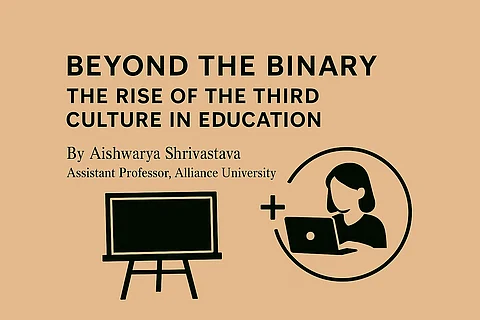

I still remember walking back into my classroom after the lockdowns lifted. The familiar whiteboard, the eager eyes of students, the quiet rustling of notebooks—it all felt surreal. After months of speaking to blank Zoom screens and unmuted microphones, being physically present again was comforting. Yet, something had changed—not just in the classroom, but in how I saw learning itself.
The world had spent two years intensely debating: Is online education the future? Or should we return to traditional offline classrooms? But as an educator who has now taught on both sides of the screen, I can tell you: this is no longer a question of “either-or.” Instead, the real opportunity lies in creating something new—something I call the Third Culture of Education.
Online learning offered us flexibility, accessibility, and the power of technology. It helped students in remote towns attend lectures by top faculty, and gave working professionals a second chance at higher education. But it also came with fatigue, distractions, and a sense of disconnection.
On the other hand, offline education gave us human warmth, spontaneous discussions, peer learning, and the structure that many students need. But it often lacked personalization, inclusivity, and the ability to adapt to individual paces and learning styles.
We tend to view these as opposing forces. But what if they’re actually incomplete on their own? What if true education begins not by picking one side—but by weaving the best of both?
This “Third Culture” is not a middle ground—it’s a new paradigm. A system where learning is blended, flexible, deeply human, and smartly supported by technology.
It lets a student watch a lecture late at night when they feel most focused, then join a lively in-class debate the next day.
It allows a teacher to track which student struggled with which concept and offer help before the next session.
It gives space for introverts to participate through discussion boards and extroverts to shine in group tasks.
It makes learning an experience, not just an activity.
As someone who works closely with MBA students, I’ve seen firsthand how powerful this can be. When students work on real-world business problems using online research tools, then present and defend their solutions in an in-person setting, the learning is deeper—and more memorable.
India has one of the youngest populations in the world, and over 315 million students across diverse geographies and economic realities. During the pandemic, EdTech stepped up in unimaginable ways. But we also saw the harsh truth: access is not the same as equity.
The National Sample Survey reveals that a mere 27% of rural households have reliable internet access. This statistic highlights a significant gap in connectivity that needs to be addressed. Even in urban India, students struggled with connectivity, devices, and digital literacy.
Yet the desire to learn remains universal. And that’s exactly why this Third Culture matters. It gives us a chance to build resilient, inclusive, student-first ecosystems—ones that do not collapse when schools shut down or when students move cities. Learning continues, because learning is no longer tied to a single mode.
There's a fear that technology might sideline teachers. But in this new culture, our role becomes even more powerful. We’re no longer just sources of information—we become mentors, facilitators, and experience architects.
It’s not about teaching more content. It’s about creating deeper learning moments. It’s about knowing when to guide, when to step back, and how to bring both empathy and efficiency into the classroom—virtual or real.
What excites me most about the Third Culture is that it mirrors how real life works. In life, we toggle between apps and conversations, solo reflection and team collaboration, deadlines and daydreams. Shouldn’t learning be just as fluid?
Let students access content on their terms.
Let them collaborate across borders.
Let assessments go beyond memory recall.
Let classrooms extend beyond walls.
This isn’t futuristic anymore. It’s already happening in forward-thinking institutions, in experimental models, and in the quiet innovation of everyday teachers who are reinventing their classrooms—sometimes without even realizing it.
Let’s move past the idea that education must be online or offline. The world has changed, and so have our learners. They need an education system that’s not bound by format, but defined by its impact.
The Third Culture of Education invites us to stop asking “Where does learning happen?” and start asking “How can we make learning meaningful—wherever it happens?”
As an educator, I no longer see my classroom as a single room with desks and a board. I see it as a living space—part digital, part physical, wholly human. And I believe the future belongs to those who can build this kind of space—not just for a few, but for all.
Aishwarya Shrivastava is an Assistant Professor at Alliance University, Bengaluru. Her academic work focuses on blended learning, educational innovation, and student-centered pedagogy in management education.
Join our WhatsApp Channel to get the latest news, exclusives and videos on WhatsApp
_____________
Disclaimer: Analytics Insight does not provide financial advice or guidance on cryptocurrencies and stocks. Also note that the cryptocurrencies mentioned/listed on the website could potentially be scams, i.e. designed to induce you to invest financial resources that may be lost forever and not be recoverable once investments are made. This article is provided for informational purposes and does not constitute investment advice. You are responsible for conducting your own research (DYOR) before making any investments. Read more about the financial risks involved here.
